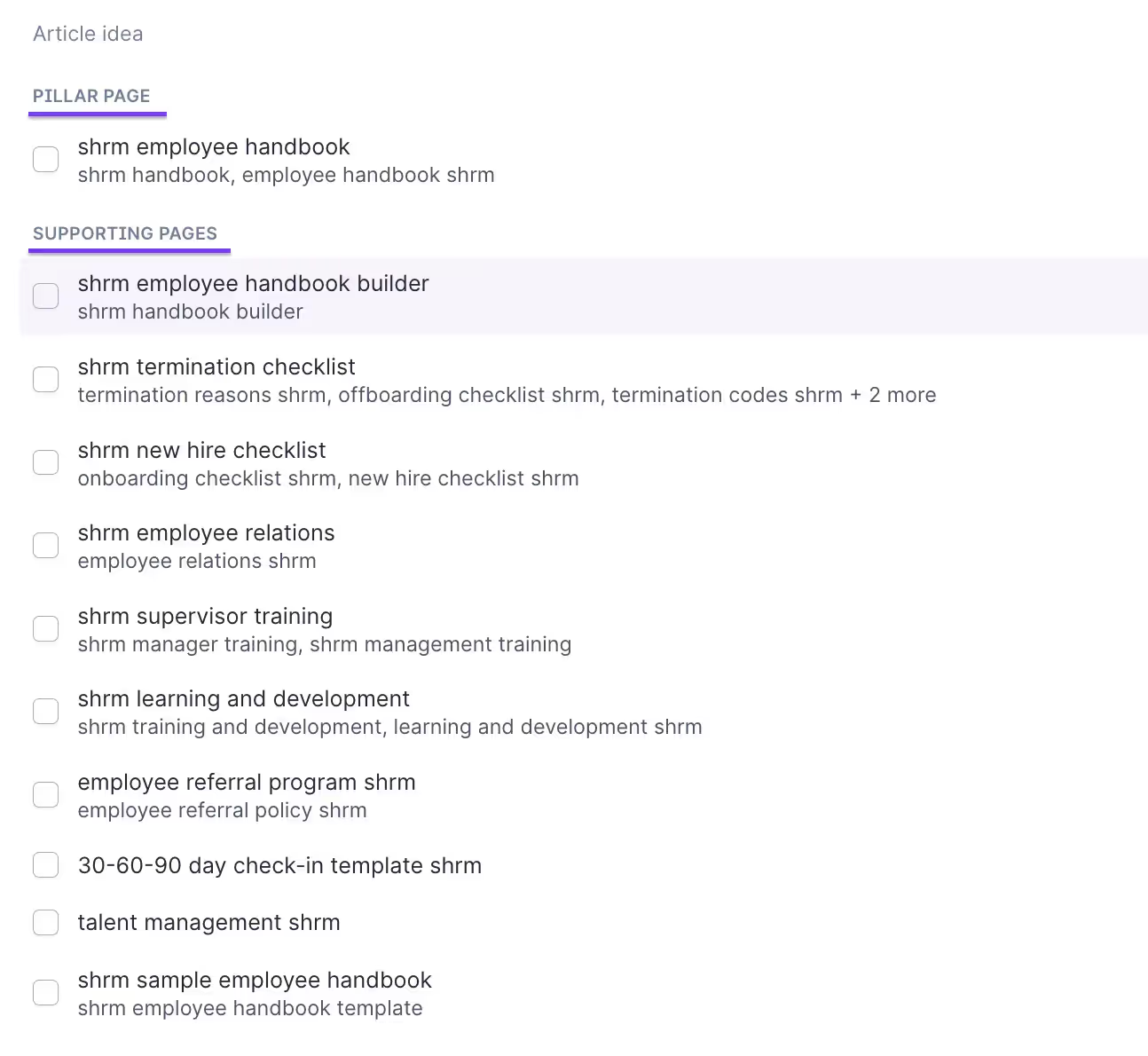The Saas company we're discussing today provides an online platform in a niche within the broader HR technology sector to create and manage digital employee handbooks. Its customer base features numerous prestigious brands, including more than ten companies ranked in the Fortune 100.
Dean Scaduto’s marketing agency, Dino’s Digital, took on the SaaS company as a client, improving organic traffic to their website by over 1300% since August 2023, multiplying daily clicks by over 17 times at the time of writing this blog post.

If you’re an agency or SEO consultant, this case study can be instructional for growing your client’s websites by combining your SEO knowledge with AI tools.
The primary objective for the SaaS website is to boost its visibility in search results significantly and to improve brand awareness among enterprise HR teams.
SEO challenges
SEO in the HR SaaS sector is particularly challenging due to high competition from established brands that have invested years in their online presence.
The complexity of HR software solutions can also complicate keyword targeting, as it requires a deep understanding to identify realistic keywords that attract traffic with business potential.
The fact that this website had previously done little SEO work made these difficulties worse, so it was like starting from scratch for Dean.
Here are 6 lessons that we can take from the work Dean and his agency did to grow the company's daily website traffic by 17x in just 7 months.
1. Identify your most important keywords
If you look at the rise in organic traffic for the company's website, you'll notice that their growth isn't slow and steady.

It's almost like the content team knows exactly which topics to go after.
Which is nearly true.
The team's keyword research strategy is quite simple.
They start by identifying high-level topics that make sense for their audience and business and then find related subtopics in the same niche.
This allows them to create a topical map that they can then blindly follow.
"We planned articles using Surfer and published the articles in clusters"
- SEO lead at the SaaS company
For example, their core topics may look like,
- employee handbooks
- employee onboarding
- workplace policies
Entering "employee handbooks" into Surfer generates a list of related keyword ideas suited to their business.
Surfer highlights the pillar page and supporting pages for a topical cluster so their writers don't have to perform any additional SEO analysis.

Identifying your main keywords is important, especially if you have a small team like they did.
By figuring out which keywords are the most relevant, you'll be able to maximize your SEO efforts.
For the SaaS team, this was the difference between getting lost in the vast sea of online content and seeing tangible results.
As a marketing agency, you can generate topical maps for multiple clients with Surfer, all in a few minutes of work.
2. Focus on one topic at a time
The SEO team at this SaaS is comprised of 2 writer-editors and an SEO strategist.
That doesn't leave much room for experimentation or a "throw and see what sticks" approach.
So the team at Dino's Digital doubled down on SEO fundamentals.
Instead of spreading themselves thin by writing about everything their target audience may be interested in, they invest all their efforts into covering one topic at a time.
Focusing on a single subject at a time allows the small team to write comprehensive, well researched articles that exceed the quality of other pages they are competing against.
So rather than writing about employee handbooks, employee onboarding and workplace policies simultaneously, they first published articles on just "employee handbooks." The narrow focus enables their small team to build and share internal knowledge on select topics reflected in their content.
Writing high-quality articles in a single niche signals subject expertise to Google, helping their SaaS pages rank higher in search results.
Working on a single cluster at a time can also simplify internal linking and content workflow.
3. Cover subjects in comprehensive depth
HR tech is a competitive industry.
I mean look at those competitors that a casual search unsurfaced.

So how could a much smaller SaaS company compete against the likes of Monday and Clickup's content marketing?
Topical authority.
Topical authority is your site's perceived expertise in a specific subject area, achieved by creating comprehensive and authoritative content that covers a topic in depth, signaling to search engines and users that the website is a go-to resource for that subject.
The team's SEO strategy is twofold.
- Focus on one topic at a time
- Cover it in great detail
Publishing enough content on a cluster like "employee handbooks" increased the site's visibility for related searches and built trust with the audience, positioning the brand as a knowledgeable resource in their field.
Using the topical map Surfer generated for them, we can see that a cluster for "employee handbooks" has 79 articles with a monthly traffic potential of 76,100 visits.

Here is a list of suggested pages for the cluster.

Even though "employee handbooks" is the main cluster under their core topic, there are several related topic hubs that the team continues to write about.

Covering these topics in great detail with high-quality content helps the SaaS website reach HR professionals seeking to create or update their company's handbook, driving targeted traffic to the site.
This strategy ensures content depth and breadth, appealing to search algorithms that favor comprehensive topic coverage.
4. Use internal linking
Adding relevant internal links is a simple SEO practice that can share link equity with other pages and help readers and search engines discover new content.
"We always internally link articles in a cluster and linked them to the pillar page"
- SEO lead at the SaaS company
The topical map feature in Surfer groups related pages by the same content hub, making it easy for the team to know which pages they have to link to and from within a cluster.
For example, here are the pillar page and supporting articles for 11 pages in a cluster for "SHRM resources."

Internal linking is a low-hanging fruit to supplement your content marketing efforts and should be part of your on-page SEO optimization.
5. Adopt programmatic SEO
The content team at the SaaS company realized that there are thousands of searches for the handbooks of popular employers.
It makes perfect sense to go after these keywords. There are hundreds of them, and combined, they have sizeable searches for a highly relevant audience.
However, creating such a vast amount of content typically demands a large team of writers.
Instead, the team combines programmatic SEO with AI content generation.
"The next two months were planned with a programmatic SEO approach where we created articles for employee handbooks of Fortune 500 companies."
- SEO lead at the SaaS company
Programmatic SEO is a way of publishing hundreds of pages in an automated manner.
Large companies have been doing it for ages. But until recently, programmatic SEO was only reserved for the big guys because it requires coding skills and integrating various data sources to create hundreds of pages.
Now, with AI, programmatic SEO is a realistic SEO strategy within reach of smaller publishers like this SaaS company.
The agency, Dino’s Digital, was able to leverage Surfer’s AI capabilities, so the client didn’t need a large writing team or an expanded budget.
Take the example of an employee handbook created for Walmart, a keyword with 480 monthly searches.

The content team used Surfer AI to generate search engine-optimized articles like this in a few minutes.

They created 200 articles in bulk for Fortune 500 company handbooks using Surfer's AI content generation capabilities.
The team adopted a good AI content practice by using AI to generate programmatic SEO content and then reviewing it by humans before publishing.
Programmatic SEO with AI is a low-effort opportunity for SaaS companies of all sizes to automate their content generation, saving time and expenses while scaling up content and traffic.
For example, their page on Walmart's employee handbooks drives over 1400 monthly clicks from organic searches.
Surfer helps them churn out hundreds of articles on these topics, which would have been an unfeasible SaaS SEO strategy with their limited team and budget.
And they have over 200 such pages.
6. Scale with AI
In the past, websites could rely on fewer pages to rank well.
However, modern SEO requires websites to create helpful content consistently, where the frequency and speed of publishing play important roles in SEO success.
The emphasis on fresh, regularly updated content is more pronounced.
With only a few writer-editors, writing hundreds of articles isn't a realistic strategy to achieve significant results from SEO in a relatively quick timeframe.
Yet their team publishes about 100 articles each month using Surfer AI.
"We post around 100 (plus minus 10) articles each month"
- SEO lead at the SaaS company
By automating parts of their SEO workflow, such as keyword research, drafting outlines, and writing optimized articles, Surfer's AI tools enable them to maintain a high content velocity that contributes to their performance on search engines.
If you are working with a client or need to create content at scale, AI content generators like Surfer AI can help you produce more articles at reduced costs and effort.
Besides these steps, the team didn't engage in additional SaaS SEO strategies like link-building campaigns or digital PR.
Results
For Dean and his agency, the ability to quickly produce a large volume of content meant the SaaS client could cover more topics within their niche and target a range of keywords, allowing them to quickly expand their website's footprint and build topical authority in their domain.
Dino's Digital grew the SaaS website's organic traffic to 4093 visits per day, recording an increase of 1300% in 7 months.

That's an increase of 17x in monthly organic visitors.
Google's algorithm updates
As you can see, Google's core algorithm updates had no negative impact on the website, even though I've demonstrated their wide use of Surfer AI content.
Unlike GPT wrappers pretending to be AI content generators, Surfer AI relies on proprietary algorithms that create humanized content for search engine rankings.
Key Takeaways
- Identifying and focusing on the most relevant keywords for your niche can significantly amplify your SEO efforts and drive targeted traffic to your site.
- By diving deep into one topic at a time, you can create comprehensive content that establishes topical authority and outperforms competitors in search rankings.
- Strategically linking related articles within a content cluster can improve user experience and help search engines crawl and index your site more effectively.
- Leveraging programmatic SEO and AI content generation allows for rapid scaling of content creation, targeting numerous high-potential keywords with less effort.
- Producing a high volume of well-researched, authoritative content is key to staying relevant and competitive in today's SEO landscape.
- Utilizing advanced tools like Surfer AI for content generation can safeguard against negative impacts from Google's algorithm updates, ensuring consistent performance in search results.


.avif)

